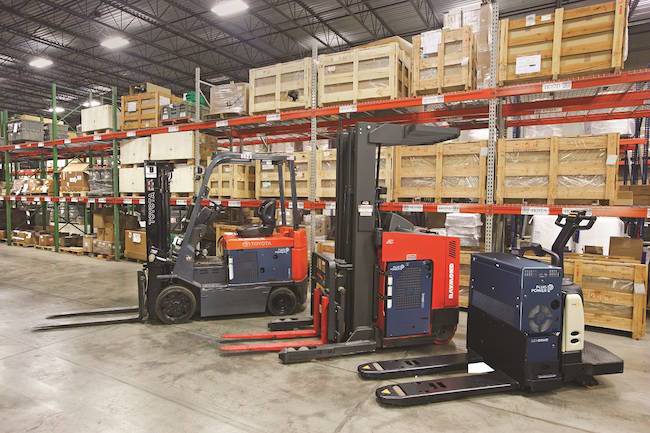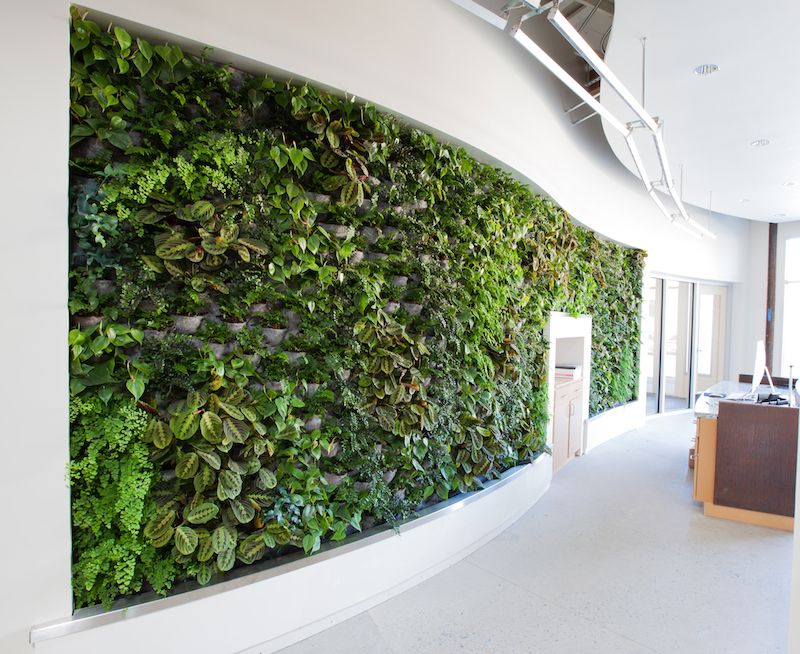By: Tina Casey on Triple Pundit

Retail giant Amazon made waves with its recent forays into the entertainment field. And now it looks like the sprawling enterprise is about to pull the rug out from under hydrogen fuel cell skeptics.
Last week the company signed a deal with fuel cell innovator Plug Power for a new generation of zero-emission, hydrogen-powered electric forklifts and other equipment at its fulfillment centers.
Warehouse operations aren’t the most exciting sector in the auto industry, but the new Amazon forklift deal could make a big difference for the future of fuel cell electric cars. That market has been slow to take off, but the Amazon announcement adds momentum to the trend, helping to keep investors and auto manufacturers interested in pushing the technology forward.
A big deal for hydrogen fuel cell vehicles
Fuel cell vehicles run on electricity, like the now-familiar battery electric vehicles. Both types of EV emit no air pollutants. The main difference is that fuel cells generate electricity on-the-go through a chemical reaction. Battery EVs run on stored electricity.
That difference looms large in warehouse operations, where excess fat shaved from time and space translates into big bottom-line savings.
Battery-powered forklifts require relatively long charging times, and extra storage space for battery charging. In contrast, fuel cell forklifts can be fueled up in a matter of minutes, like an ordinary gas-powered vehicle, and they don’t require a “battery room” or other excess storage.
Hydrogen fuel cell forklifts have already begun to establish a solid track record in the logistics sector, and it looks like Amazon didn’t take much convincing.
The recent deal enables the company to acquire more than 55 million common shares in Plug Power in connection with a $600 million commitment from Amazon to purchase goods and services from Plug Power.
This could be just the beginning…
Amazon and Plug Power plan on a relatively modest start for the new venture, with a total of $70 million in buys this year for fuel cell equipment at selected fulfillment centers.
What’s really interesting about the deal is the “and services” part of the agreement. Forklifts appear to be just the start of a wide-ranging collaboration between the two companies, leading to other applications.
Here’s Plug Power CEO Andy Marsh enthusing over the potentials:
“This agreement is a tremendous opportunity for Plug Power to further innovate and grow while helping to support the work Amazon does to pick, pack and ship customer orders. … Our hydrogen fuel cell technology, comprehensive service network, and commitment to providing cost-savings for customers has enabled Plug Power to become a trusted partner to many in the industry and we are excited to begin working with Amazon.”
To put this in perspective, consider that just a few years ago it was difficult to get investors interested in fuel cell technology. The hydrogen economy dream was hitting a harsh reality — namely that the technology was not quite ready for prime time. Growing competition from battery-powered EVs also helped to shove hydrogen fuel cells down the ladder.
TriplePundit’s RP Siegel interviewed Marsh about the fuel cell dilemma in 2012, and the CEO made these observations about Plug Power, forklifts and the future of fuel cell EVs:
“With limited capital, we had to be selective in our decisions about which markets to go after. … The one that really jumped out at us was replacing batteries in fork lift trucks with fuel cells. How big of a market could that be? Well, in the US there are over 1.5 million forklift trucks, and worldwide, the number is 6 million.
“We chose this market because it was a way to build a profitable business that would allow us to attract large customers in a relatively large market … as we continue to drive down our costs, we should be at parity with IC [internal combustion] engines in five to six years, at which point we’ll be ready to expand into other areas.”
With the new Amazon partnership, it looks like Plug Power is hitting that five- to six-year timeline for growing into other areas.
Fuel cell EVs hit the streets
Just a wild guess, but in a few years you could see Amazon introduce its own fuel cell EV for street use.
That may seem far-fetched, but consider that Google began dabbling in the related field of self-driving cars in 2015 and is now a burgeoning leader in the space. (That project has since been transferred to Google’s parent company, Alphabet.)
Apple is also inching into the self-driving car market.
Intel is another tech company putting feelers into the self-driving sector. Just last month it took a giant step with a $15.3 billion acquisition of the Israeli startup MobilEye.
Amazon will have to act fast if it wants to catch the train. Mainstream auto manufacturers are beginning to add fuel cell EVs to their rosters at a quickening pace.
Toyota was among the first to make a firm commitment to the field with its fuel cell Mirai. The company’s efforts include the all-important transition to sustainable hydrogen and support for growing the network of hydrogen fuel stations, along with a foray into the forklift sector.
Other companies introducing fuel cell EVs to the consumer market include GM and Honda.
So, who’s giving fuel cell EVs the stinkeye?
In response to the Amazon fuel cell forklift news, last week MIT Technology Review pumped out a brief article with this observation about the consumer market:
“Attempts to convince the public to embrace hydrogen-powered cars have flopped. While some automakers continue to push on with the vehicles, other are increasingly having second thoughts.”
Calling Debbie Downer!
On the brighter side, last December the journal IEEE Spectrum took an in-depth look at the potential for the fuel cell EV market to bust loose, penned by the director of the National Fuel Cell Research Center at the University of California, Irvine.
The article emphasized that both battery and fuel cell EVs will have a place in the zero-emission market of tomorrow, but fuel cells will give batteries a run for the money based on a number of advantages including range and refueling time.
The author, Scott Samuelson, also makes a good case that excess renewable energy can be used to manufacturing sustainable hydrogen for fuel cell vehicles.
That growing market could provide an important incentive for investors to accelerate the pace of renewable energy development.


